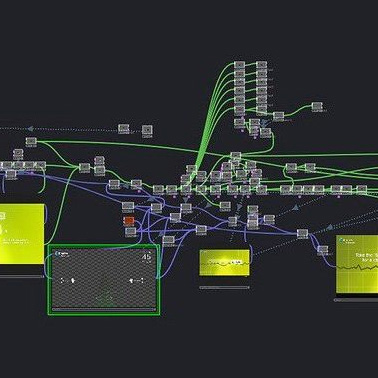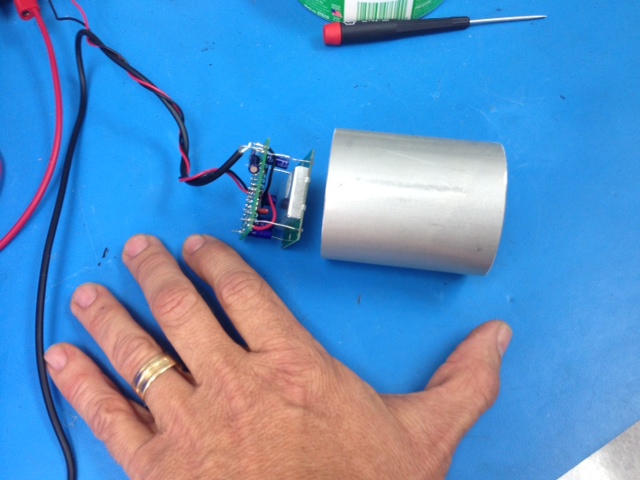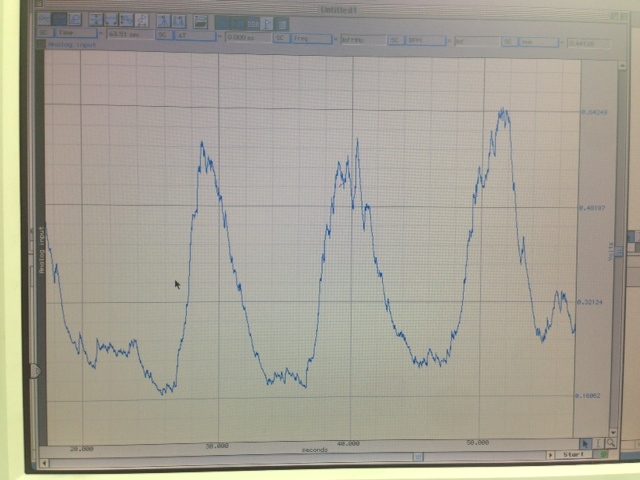IAM
Control Tower
_________ __ .__
\_ ___ \ ____ _____/ |________ ____ | |
/ \ \/ / _ \ / \ __\_ __ \/ _ \| |
\ \___( <_> ) | \ | | | \( <_> ) |__
\______ /\____/|___| /__| |__| \____/|____/
\/ \/
___________
\__ ___/_____ _ __ ___________
| | / _ \ \/ \/ // __ \_ __ \
| |( <_> ) /\ ___/| | \/
|____| \____/ \/\_/ \___ >__|
\/
l00nie-crew hacker page Six26 (talk) 21:09, 10 July 2013 (UTC)
http://internationalartsmegacrew.com/controltower/
- Lasers
- One big one with sweeper
- ~4 inner lasers
- Fire
- 8 Points w/2 Flame effects
- Giant fucking! one on top
- Lighting
- RGB LED Spots ~16-24
- Doppler Radar
- AudioPixel
Control Tower Storyboard
Crowd Sensors
More DopplerCan
- 8 Doppler Radar Cans
- Analog signal output (0-5VDC, 0-2Hz)
- Interactions quantified in 8 sectors
Doppler sensor guts and aluminum housing. Can mount housings directly to bamboo structure or rivet with brackets.
The data has a baseline voltage of about 0.20vdc and typical peaks of about 3 volts. Maximum output range is presently 0 to 5 volts DC.
The baseline of 0.2vdc represents the "noise floor" of the sensor. This is the voltage output with no observable motion out to about 10 meters away, assuming an object the size of 1 person.
Sensor output data, shows a person about 4 meters from sensor taking one step forward, one back, then waiting about 10 seconds and repeated three times.
The Dopplers are designed to output a smoothed wave which indicates a combined "motion" and "size/distance" value. A small object, moving any direction, close to sensor, will read similarly to a larger object moving faster, proportionately further away.
The Doppler system should be able to recognize certain type of synchronized group motions. For example, if 8 people start walking towards the tower pillars (those with Doppler attached) then the signal on all 8 dopplers will start growing in amplitude. As soon as they stop walking, no matter where, signal outputs return to baseline.
For power, the sensors need +5 VDC and Ground. Current needs are about 40ma each. The sensors output a single-ended, voltage output (0-5Vdc), to be received by the A/D host. Sampling rate, to acquire Doppler output voltage signal, should be at least 10 Hz.
Eight of these sensors in total are planned, with all 8 pointing down to playa, creating eight overlapping zones of sensitivity - each zone about 20 feet in diameter at base, with a Doppler at the apex of each zone.
Sensors are proposed to be placed on a ring around the circumference of the tower, perhaps 10-12 feet off the ground. One Doppler sensor per tower leg, pointing to the ground, roughly parallel to the leg. Sensor beam scatters out to about a 2X diameter circle, for sensor height X.
All sensors are pre-wired with RJ45 to central hub (1" x 4" x 7"), hub can accept +12vdc or +5vdc, and the eight analog signals, plus ground can be piped around with 10, or higher, conductor cable, with additional shield.
Suggestions for software processing:
The sensors will collectively report a "crowd movement and density function". The Dopplers only report motion in sensed zones, so if crowd is slow-moving and/or consists of a few people, then average Doppler signal report will be low. However, in this case, one sensed zone may easily report more activity than another. This might be the case at 6AM in the morning when just one or two people might be hugging a tower leg.
On big nights, there will be many people walking around and underneath tower. In this situation, Doppler zones will all be reporting similar values, assuming people are behaving similarly to gas molecules in Brownian motion. If all the Doppler outputs are summed, then an indicator would be developed which would be indicative of average velocity of each person in the entire sensed area. It's difficult to imagine a case where this average velocity might substantially change, unless this request might somehow be delivered to the milling group via megaphone. As example, if people were to stop moving in vicinity of tower and then to suddenly start jumping, this collective change in state would be very noticeable to Dopplers. The average output level would certainly rise.
An interesting area to explore might involve melding a small group with the tower's presentation abilities, where the small group represents a locus of movement. In this case, the group of 5-10 people might be huddled together and moving quickly. As the huddled group moves in and around the tower, it will pass through zones, thus lighting up that zone in proportion to all others. If the general population could be kept 20-30 feet away from the tower base, the small group's activities would clearly register on the tower's effects. Even a single runner, or two runners, starting slower, then increasing circumferential velocity, could show as corresponding motion on tower lighting.
In any case, as the Dopplers faithfully report the "crowd movement and density function" and as motion and density both increase, the Dopplers will report higher voltage values. The speed of the Doppler voltage output is low, in the range of DC to 1 Hz, and well under audio frequencies. It seems that any software-based processor should provide threshold levels to trigger tower functionality, based upon Doppler voltage output. Ideally, these thresholds should be software-tunable, so the tower's operation can be dialed in. Also, it may be worthwhile for the software to provide some ability to sum (average) the collective Doppler outputs, prior to running this average indicator though tunable level triggers.
An A/D sampling at 10Hz or higher, with a resolution of 8 bits or higher, would be plenty to comprehensively digitize the voltage signal from each Doppler.
Flame System
- 18 Different effects
- 16 Perimeter Effects
- 60' Fire Ball
- 250 Gallon/nite limit
- Manual Control & Automatic Mode
- Insane
Laser System
AudioPixel
More on AudioPixel lighting interaction software
l00nie-PET
- UDP Ethernet based event broadcaster
- A/D Converter for DopplerSensor. (Please describe specifications: input voltage range, frequency response)
Black Box
Testing and manual control interface rig.
Calendar
- Saturday, July 27 - Compression Fire & Art Festival
- Fri, Sat, Sun August 2-5 - AudioPixel (Erin & Hepp) out at Raindance Festival
- Mon Tues August 6-7? - AudioPixel in Reno / Warehouse to work
- ~August 15th - Advance Team
- Fri August 23 - AudioPixel crew arrives on-playa
- September 5th - Wrap Up





